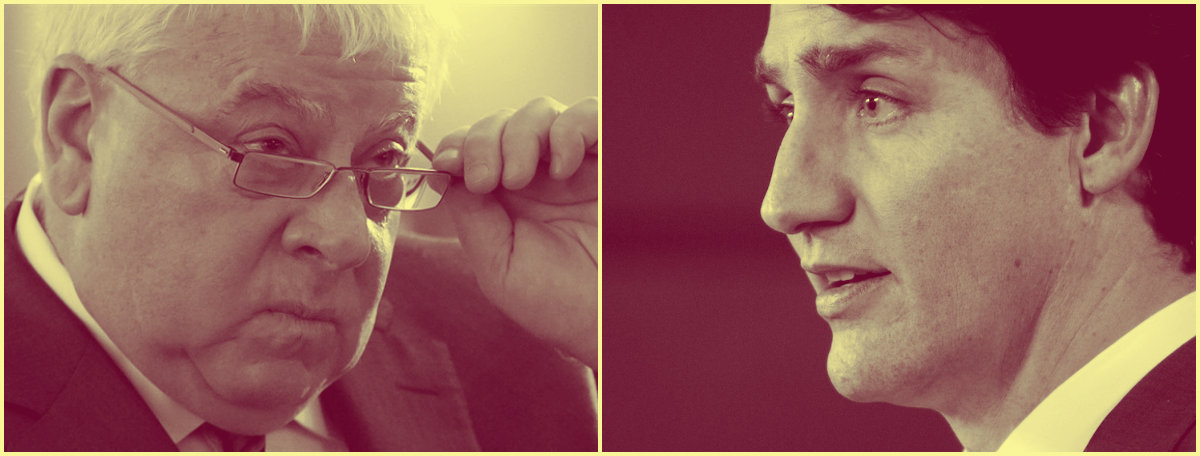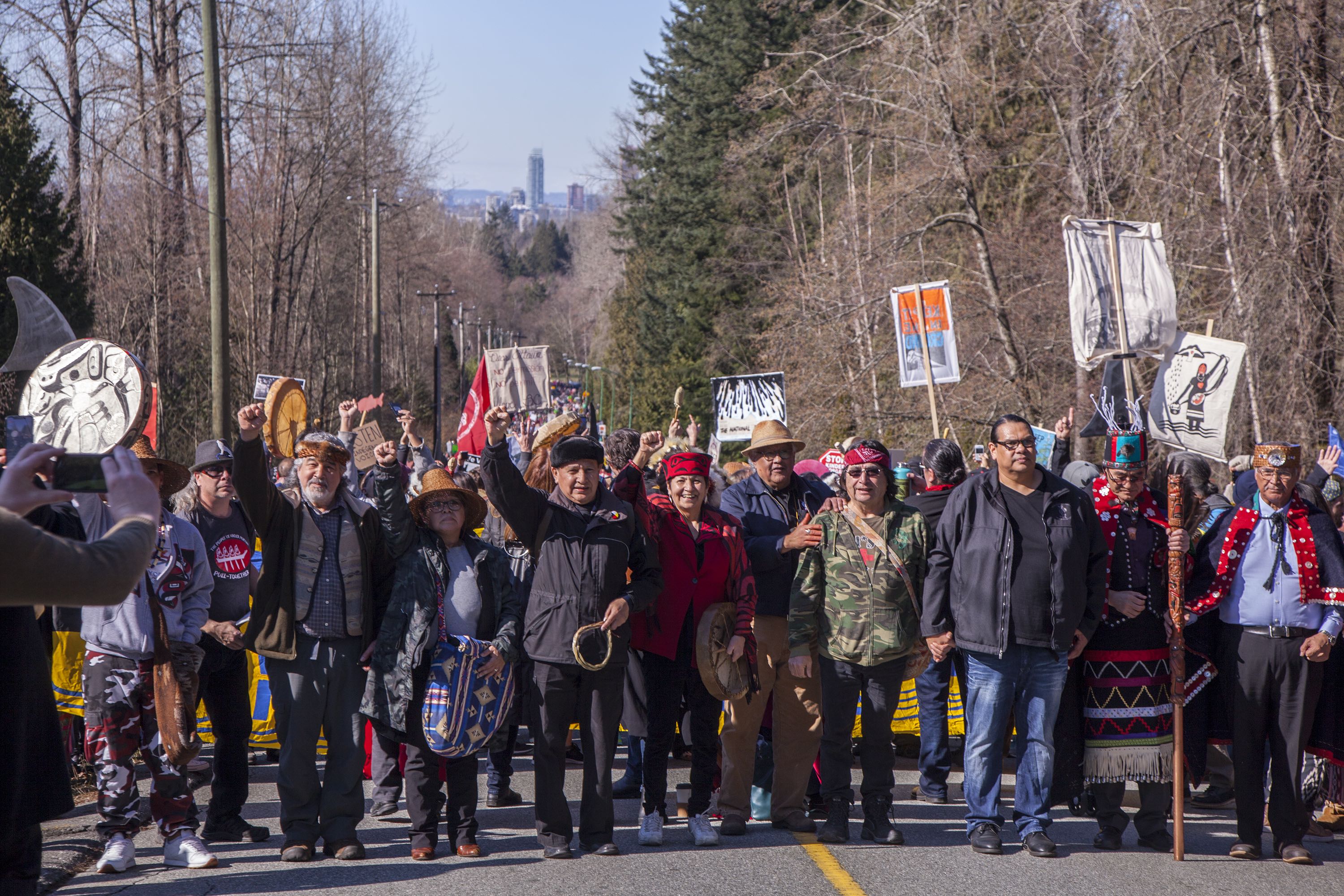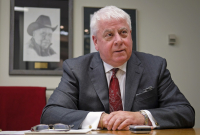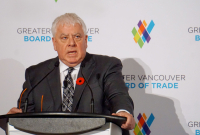In an unusual action for a Sunday afternoon, on April 8, 2018, Kinder Morgan Canada Limited (KML) issued a press release announcing it had taken the Trans Mountain pipeline expansion project hostage. The company said it was suspending “all non-essential activities and related spending” on the project.
The demands? Meet two conditions by May 31 or Trans Mountain’s expansion would die.
The two conditions? Final clarity on its ability to construct the project through B.C. and adequate protection of KML shareholders.
Kinder Morgan executives said it would meet with negotiators to discuss the detailed terms of release.
The urgency and drama surrounding Kinder Morgan’s hostage-taking — and the company’s aggressive attack against the Province of B.C. as the reason behind it — is grandstanding.
Kinder Morgan has known since late last June that British Columbia’s newly elected government ran on a promise to stop the project arguing it is not in the public interest. Premier Horgan has not betrayed the public trust by breaking his election promises as did Prime Minister Trudeau. Kinder Morgan failed to take Horgan seriously. The company should have. It is Kinder Morgan’s shareholders who should bear the cost of Kinder Morgan’s executive decisions — not taxpayers.
Kinder Morgan’s fanfare announcement is a cover-up. Trans Mountain pipeline expansion lacked commercial viability from the get-go. It has required government supported handouts at every stage of development. Kinder Morgan has put very little shareholder capital at risk. It has always looked to others — the shippers, Canadian investors and Canadian taxpayers — to do so.

Upside potential with none of the downside risk is a sweet deal. The Texas-based company — forged from the executive ranks that ran Enron — wants to keep it that way.
What exposure do Kinder Morgan’s shareholders have?
Kinder Morgan’s shareholders have almost nothing at risk — somewhere around $200 million. Sure, project spend to date is $1.1 billion but Kinder Morgan has confirmed these costs are reduced by $210 - $220 million through the Firm 50 Fund granted to the company in an unprecedented NEB approval in 2011.
Oil producers fought this approach. They knew it would distort market signals and exaggerate the project’s commercial viability. Chevron described it at the time as an “extraordinary precedent … If they (Kinder Morgan) need financing, then they should go to the market” and get it.
Further, the early termination clause 5.4(b)(i)(A) in Kinder Morgan’s contract with long-term take or pay shippers means oil companies pick up 80 per cent of costs. So, Kinder Morgan’s shareholders are exposed to only about 20 per cent of the $900 million — or roughly $200 million.
For Kinder Morgan to proceed it will likely want Ottawa to protect its shareholders from exposure beyond what they now have at stake. The “adequate protection of shareholders” Kinder Morgan seeks, when Kinder Morgan has almost no skin in the game, is a very expensive proposition for Canadian taxpayers on a go forward basis.
Financial challenges evident for years
Kinder Morgan will also want Ottawa to underwrite the project’s financing challenges.
These have been evident for years. The NEB was supposed to protect Canadians by uncovering such failings during its review of the project. Instead, the NEB turned a blind eye to Kinder Morgan’s financial risk and Trans Mountain’s lack of commercial viability.
In early 2013, Kinder Morgan told the NEB during the toll hearing process that Kinder Morgan Energy Partners, LP (KMP), a U.S. master limited partnership which then owned Trans Mountain, would be the sole source of financing for the project — KMP would be responsible for securing all debt and equity required. Ian Anderson, president of Kinder Morgan Canada, confirmed during cross examination at the toll hearing that “KMP…(is) my sole source of capital.”
Throughout the NEB public interest review, Kinder Morgan maintained this commitment. Its application filed in December 2013 states that, “The expected capital cost for the Project is approximately $5.5 billion. Financing will be arranged by Trans Mountain’s parent company KMP.”
In 2014, KMI restructured and KMP ceased being an entity capable of fulfilling the financing commitment. However, KMI could not step up and fill the funding gap. KMI had taken on so much debt — it was so highly leveraged — that capital markets were no longer willing to provide debt or equity to KMI for it to fund Trans Mountain’s expansion.
As an expert intervenor, I advised the NEB in November 2014 that Kinder Morgan was no longer able to live up to its commitment to provide project financing. I alerted the NEB that Canadians would be put in harm's way if the Board would not recognize or address the financing weaknesses at KMI. The NEB refused to heed the warning. What’s worse, the Board told Cabinet a year and a half later, there was no problem.
The NEB report released in May 2016 states that, “Trans Mountain said that the expected capital cost for the Project is approximately $5.5 billion. Financing would be arranged by Trans Mountain’s parent company, Kinder Morgan Energy Partners, L.P. (KMP),” when the Board knew this was neither true or possible.
Kinder Morgan’s capital cost rose to $6.8 billion in October 2015 — six months before the release of the NEB report to Cabinet.
The National Energy Board misinformed Cabinet on two key issues. The capital cost for the project had risen by 25 per cent while the Board maintained it had not; and there was no longer a Kinder Morgan entity capable of delivering on the funding promise, while the Board pretended there was. The NEB should have, but failed to include among its 157 conditions, a requirement that Kinder Morgan live up to its financing promises.
Why is no one holding Kinder Morgan to account?
This intergovernmental fiasco that threatens to rip Canada apart and cost taxpayers billions could have been avoided if the NEB had done its job and ensured the project was financially viable before it recommended to Cabinet that it proceed.
Ottawa could have recovered the NEB’s fumble if it had spent any of the time it set aside after receiving the NEB report to actually understand the business case, rather than designing a spin campaign for a project it always intended to approve.
How much does Kinder Morgan want?
KML needs to raise more than $2 billion in equity to fund the current cost of its project. It is also directly on the hook for project cost overruns beyond the uncapped line items in its increased $7.4 billion budget — a budget that, when revised again, will likely be over $9 billion. As well, the company still needs to come up with $1.1 billion in financial assurances required in Condition 121 of its certificate.
Even if the project were to proceed into full construction mode this summer — a date Kinder Morgan always knew was the earliest possible pipeline construction start date given NEB mandated route hearings — these funding challenges would still need to be met. These billions in financial requirements have nothing to do with Province of B.C. actions, but when they show up in Ottawa’s bail-out package the Province of B.C. will be blamed.
Why so much?
KMI washed its hands of financial accountability to, and financial responsibility for, Trans Mountain’s expansion back in 2014, but did not need to provide an alternate financing plan for the project until it was certain Ottawa would give the green light.
KMI attempted to find a joint-venture partner for the project but there were no takers. It then decided to hive off its Canadian assets into a public entity and one year ago, KML was born.
None of the proceeds from KML’s Initial Public Offering (IPO) were retained for use in the project. The $1.7 billion capital KML raised in Canada was sent to Houston to pay down debt the parent company, KMI, owes.
Last July, KMI (the U.S. parent) announced that KML would be self-financing. It identified the outstanding equity the Canadian company would need: KML would need to raise $2.1 billion.
The NEB based its recommendation to approve Trans Mountain’s expansion — and Cabinet in turn based its decision to grant the certificate — on a financial commitment Kinder Morgan publicly broke without so much as a sideway glance from Natural Resources Canada (responsible for the NEB) or the Department of Finance (now behind the bail-out package).
KML raised $550 million through two preferred share offerings between August and December 2017, but costs over the past year have mounted sending the requirement north of $2 billion.
A little over a year after receiving its certificate to proceed with the project, KMI has removed itself from any responsibility for financing the project, offloaded the responsibility to the Canadian capital markets through KML, kept 70 per cent of the upside potential, and with Canadian capital markets now wary, has turned to Ottawa to close the gap.
Why are project overruns a concern to shareholders if shippers have signed long-term take or pay contracts?
The NEB issued the Certificate of Public Convenience and Necessity (CPCN) on December 1, 2016. As part of shipper contract terms, Kinder Morgan was required to provide an updated budget called the CPCN budget, so shippers knew what their new, higher toll rates would be. This CPCN budget is the $7.4 billion project estimate developed over a year ago.
The CNCP budget also included an identification of capped and uncapped costs. If the cost of the project were to exceed $7.4 billion, uncapped cost increases get passed onto shippers through higher toll rates, while increased costs in the capped portion are borne by Kinder Morgan.
Capped cost are of serious concern to Kinder Morgan. If the company is on the hook to pay a portion of the construction costs, that revenue must be obtained from other — non-Trans Mountain — KML assets because Kinder Morgan doesn't own the products shipped down its pipeline. This directly compromises KML’s cash flow and has a significantly negative impact on its shareholders. Since KMI owns 70 per cent of the company, this means KMI shareholders. Under this scenario, KML’s share value would likely plummet.
Capped costs include the majority of project construction segments outside of the lower mainland.
Kinder Morgan desperately wants to avoid shareholder responsibly for these costs — even though the company promised the NEB during the toll hearing it would have no problem picking them up.
At this point, Kinder Morgan is unwilling to provide an updated project budget. In its ransom note, Kinder Morgan asserted, “Given the current uncertain conditions, KML is not updating its cost and schedule estimate at this time.”
Why not? If there is any point at which the public deserves to know how much the project is likely to cost based on what is known to date, it is now when the public is being asked to foot the bill.
Certainly the investment community that has advanced Trans Mountain’s construction loan has a better understanding of the capital cost risks of the project and the proportion that are capped costs. Capital markets are too smart to knowingly provide more financial support to KML when higher capped costs will need to be borne in part by the earning potential of assets that have nothing to do with the pipeline.
Ottawa stepping up with taxpayer money to absorb capped cost overruns is likely on the agenda at the negotiations.
What is the $1.1 billion in 'financial assurances?'
Trans Mountain’s expansion is risky. The potential for a pipeline spill or a tank farm explosion is real.
In an attempt to address the risk, the NEB required that Kinder Morgan provide an additional $1.1 billion in financial assurances in certificate condition 121 which is over and above the $1 billion required for the spill risk on the existing pipeline. If the project proceeds, Kinder Morgan will need to hold an aggregate of $2.1 billon as financial assurances against land-based environmental risk.
Financial assurances plans have an ongoing cost and Kinder Morgan will want to protect its shareholders from this risk. It is very likely that, as part of current negotiations, Kinder Morgan will try to offload the cost of Condition 121 onto Canadian taxpayers.
Kinder Morgan’s hidden condition #3
Even If Ottawa delivers piles of cash and demonizes the B.C. government to pave the way, Kinder Morgan has said it may not proceed with the project. The company waited until its investor analysts conference call in Houston the Monday morning following the hostage-taking to explain a separate — and very significant — condition.
Kinder Morgan Inc. (KMI), CEO Steve Kean (also Chair and CEO of KML, and former chief of staff and head of government relations for Enron) confirmed that, “Even if we have the other [two] things in place, we still need to see a resolution of [the Federal Appeal]…” referring to the court case challenging Federal Cabinet approval of Trans Mountain’s expansion heard by the court in Vancouver, last fall.
Resolution, according to Kean, is an unequivocally favourable ruling for Kinder Morgan with no further court action possible — “final clarity,” he called it. He said that even If there are “things” that the court recognizes that need more work — as was the case with the court ruling on the judicial review of the Northern Gateway approval — Kinder Morgan has decided that this would be “too much to bear given the point we are.”
Clearing this third condition has nothing to do with B.C..
Why grandstand now?
Why would Kinder Morgan issue a press statement on April 8th, with a May 31 deadline leaving the impression that if Ottawa steps up and meets the two conditions, construction will proceed? The company knows it will not make a final decision on the project until the status of its third condition is certain. Why not wait for the ruling from the federal court and proceed from there?
There is the significant benefit Kinder Morgan receives from a generous benefit package developed by desperate politicians in Ottawa and Alberta. But why make it a public display? Kinder Morgan executives regularly meet behind closed doors and cook up deals with Ottawa and Alberta.
Things just don’t add up.
Looking deeper, Kinder Morgan has a business reason for its staged theatrics. It is imbedded in the default provisions of the $5.5 billion loan facility agreement the company has with Canada’s banks.
The loan facility consists of a $4 billion construction line to support the Trans Mountain expansion project capital costs of $7.4 billion.
The facility also includes a $1 billion construction contingency line available for project overruns.
Then there is a $500 million credit line available for general corporate working capital.
Kinder Morgan began drawing on the loan facility agreement shortly after it was entered into last June.
According to the loan agreement, suspension of all (or substantially all work relating to the development, construction and completion of the project) qualifies as a loan default event. However, if Kinder Morgan publicly establishes that the reason for the project suspension is due to circumstances beyond its control, the facility is not compromised.
Kinder Morgan’s financial challenges are explicitly identified in the loan agreement as being in Kinder Morgan’s control. Government actions are not.
Looking back, this is not the first time Kinder Morgan has established a red herring argument pointing to a delay by government to justify a suspension of construction spending.
Kinder Morgan announced on December 4, 2017 that the company had embarked on a “primarily permitting spending strategy.”
Kinder Morgan said then that “the scope and pace of the permits and approvals received does not allow for significant additional construction to begin at this time.”
It was not the City of Burnaby that was in the way of Kinder Morgan commencing construction, as Kinder Morgan claimed. It was the ongoing NEB route hearings and condition compliance requirements attached to its certificate that would not allow construction to commence until at least June 2018.
But Kinder Morgan had a problem. It had told its bankers and investors construction would commence in September 2017, although it knew there was no way it could do so given NEB requirements. Kinder Morgan needed believable cover, and used the City of Burnaby as a shield.
It blamed the City of Burnaby for the suspension of construction spending back in December. "To that end, we have filed motions with the National Energy Board (NEB) to resolve existing delays as they relate to the City of Burnaby, and to establish an open NEB process that will backstop provincial and municipal processes in a fair, transparent and expedited fashion."
The NEB, in true captured-regulator fashion, delivered. It overrode the City of Burnaby’s permitting authority and set up a standing panel to deal with municipalities and provinces should further situations arise.
Still, this was not enough. Kinder Morgan didn’t commence construction after the NEB cleared the City of Burnaby from its path. The reason is because it was never the City of Burnaby that was in the way, just as the Province of B.C. is not the cause of Kinder Morgan's current circumstances.
It is time to stop feeding the monster that Kinder Morgan’s Trans Mountain expansion has become.






Comments
Please put this column and Kevin Taft's from May 12 to our Finance Minister before his announcement tomorrow, and have him respond to the business case, or lack thereof.
Climate change is like a larger and more deadly Lac Megantic, waiting to happen. Our children are down in the valley living their lives in hope that their parents and government leaders have their backs, while our federal and some provincial government leaders are making sure a deadly fossil fuel bomb is parked unsafely above them, brakes wilfully taken off, and left to barrel unstoppably toward them. Across BC people are losing their homes and livelihoods in floods, while we await the inevitable wildfire season, that will threaten many more. People in NB have suffered, and all those in between and beyond can count on worse and worse catastrophes in the years ahead, not to mention food insecurity, loss of agricultural land, migration of disease vectors, sea level rise, coastal erosion, and worse.
We need responsible and educated government members, honest and ethical enough to look at what the science is telling us, and to take urgent mitigative action. Pretending the problem doesn't exist is an abysmal moral failure. Making taxpayers pay money to a corporation to ensure that our children's collective future is laid to waste is the action of a group of sociopaths. Trudeau, Notley, Kenney, Ford, Morneau, Carr, McKenna, even that supposedly thoughtful Nenshi, are all happy to burn up tomorrow for some bucks and popularity today.
Dear SE,
Your comments are so brilliantly articulated. I am speechless. The Lac Megantic image you offer is absolutely brilliant.
Would you be agreeable to my copying this and sending it to my friends and fellow activists (in Ontario)?
Anyway, thank you so much.
Ruth
A detailed, brilliant and necessary bit of reporting. I hope it gets wide exposure.
An interesting and enlightening read. This game of smoke and mirrors between KM, Alberta and Federal gov is for what? Public theatre? This morning Morneau claimed that feds will cover any losses KM sustains during construction? I am in disbelief that our governement is propping up a poor business decision like this. Obviously the egg heads at the NEB are all sunny side up? Must be nice to write cheques at the expense of the common Canadian taxpayer.
Thanks again Robyn. You are doing more to educate Canadians than any of our governments, including the BC government. Morneau is either ignorant or dishonest in his willingness to burden Canadians with this project. And where is the CBC and Global and CTV and the Globe and Van Sun and TC in giving coverage to this instead of being suckers for promoting the oil industries weak jobs story - I say weak because most of the jobs are temporary construction jobs as the project transacts the province. And this is nothing compared to the irony of Morneau coming to BC when we have record braking high temperatures and record breaking flooding, all linked to climate change - which Canada is committed to fighting but doing nothing to achieve our goals and instead is promoting a substantial increase of carbon emissions by promoting this project which will triple the generation of CO2 emissions from the crude the expanded KM line will carry.
So not only are we supposed to be happy about new infrastructure that will help exacerbate CO2 emissions for 40 or 50 years. We're supposed to pay for it. That would constitute aiding and abetting graduates of the Enron school of larceny. NO THANKS!
How much renewable energy infrastructure could we build with the money our federal Libberal turncoats are proposing to shovel to KM?
This discussion has to move into the BC banking circle. Kinder Morgan is insolvent
Ordinary BC financial consultants, loan officers, bank managers, tellers, pension investors have to evaluate sinking ship.
Why would Kinder Morgan NOT back out at the end of May ?!?
So much written about KM, so much emotion. This is a great piece. It is insightful— gives us the biz case — and adds specifics to the general flow of info. A look into the boardroom that we don’t always get. Kudos to the author and NO for this opinion/analysis... No, definitely no to KM.
Remember: the Liberal RULE is always Win the Next Election ! They approved the TMX for the BC Liberals however after losing the election TMX is now a NDP/Green pipeline. That was LOSS #1 . They cannot lose the challenge by opponents to their Constitutional Authority that TMX is essential to the Canadian Economy and Survival. They are willing to spend $4.5 plus maybe $12 of taxpayers money to avoid LOSS #2. Only the name has changed. Risk of spills, uncertainty of Orders and dedication of Opponents has not changed. It is time for Canadian Engineering and Political Negotiation and Compromise. rt